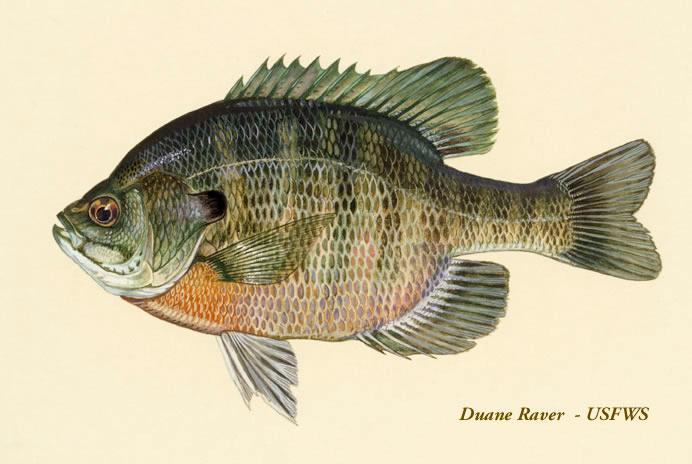Description and Range
Physical description
Bluegill is one of several "panfish" species in Washington which is very popular across the state because they are easy to catch, they are a great "family fishing activity" and they make excellent table fare. Often mistaken for pumpkinseed sunfish, bluegill are distinguishable by a darkened blue spot on the posterior edge of the gill plate. The sides of the head and chin are often a dark shade of blue and there are 5-9 vertical bars along the sides of the bluegill; however, these are not always distinct.Average 4-8 inches. Bluegill can grow to 6-11 inches in quality populations.
Where you may encounter bluegill
Bluegill can be found statewide, however, quality bluegill lakes are often tough to find and size distributions within lakes can vary quite significantly over the span of a few years. Historically, the lakes, ponds and reservoirs of the Columbia Basin Project have produced excellent bluegill fishing. In addition, numerous lakes in western Washington provide excellent bluegill fishing.
Lakes where this species may be found
How to fish for bluegill
Fishing prospects calendar
Bluegills are a popular panfish that can be caught with live bait (worms, maggots, crickets, grasshoppers) flies, crappie jigs, pieces of corn, small crankbaits and spinners. During their spawning period (water temperature >70°F) bluegill can be caught on almost anything (even a bare hook) cast near their nest. While catching bluegill in general is easy, catching quality-size bluegill is more difficult. Quality-size bluegill are not found in every water bluegill live in because their populations are quite cyclic with regard to the abundance of large fish. Bluegill fishing is best in spring and summer as fish congregate to spawn.
Bluegill feed mainly on aquatic insects, which are slow-moving creatures. Rarely will a bluegill chase food items; therefore, it's important to fish very slowly. This is true whether you use artificial lures or live bait.
Bluegills have small mouths and a small hook is essential: sizes 6 or 8 seem best. Hooks with long shanks are easier to remove from their small mouth, especially if the bait is swallowed. Thin wire hooks are the choice with live bait because the bait will stay alive longer and will be more enticing to fish as it squirms on the hook.
Artificial baits suitable for catching bluegill are numerous. One-thirty-second and one-sixty-fourth ounce lead-head jigs with a plastic skirt, although tough to cast with anything but ultra-lite gear, are exceptional bluegill catchers. Leadheads tipped with marabou feathers, rubber grubs, or twister tails all work well. A small piece of worm or maggot attached to the lure will often increase bites when the fish are exceptionally choosy. All colors catch bluegill, but black is preferred by the most ardent 'gill fishermen. Tiny spinner-baits, spinners, and weighted flies can be used with spinning gear to catch big bluegill. Fish these baits as slowly as possible for best results. Dry flies and small poppers can be used with a spinning rod if a small float is attached about 4 feet from the lure. Long casts with a jerky or twitching retrieve will take bluegill when they are feeding on the surface.
State record
- Weight
- 2.33 lbs
- Angler
- Ron Hinote
- Location
- Tampico Park Pond, Yakima County
- Date Caught
- June 10, 1984
